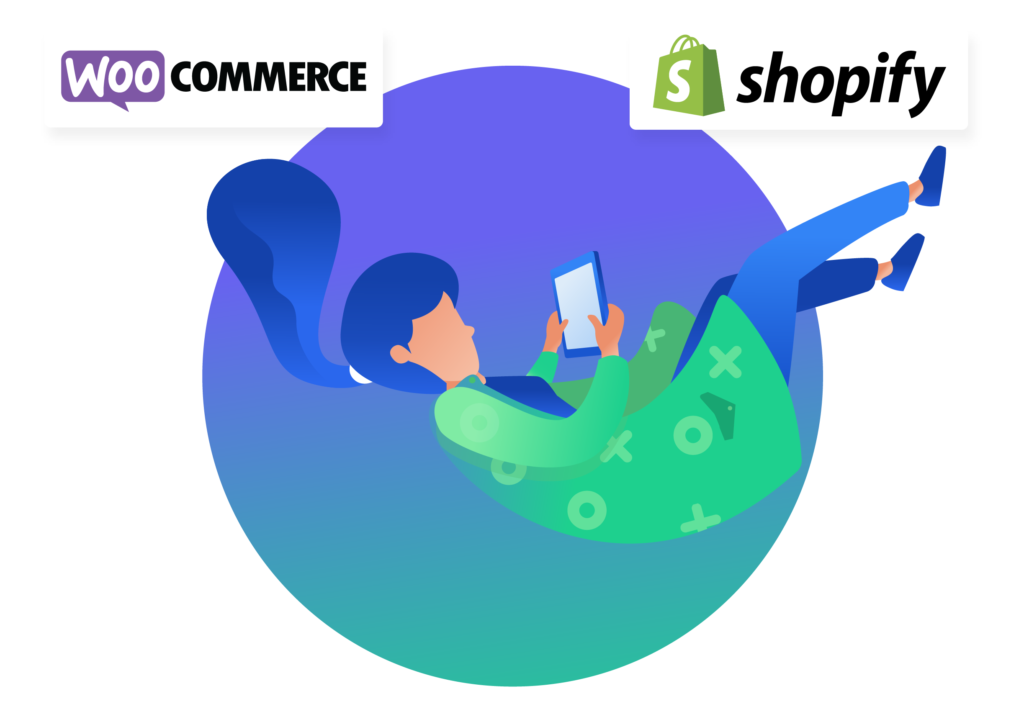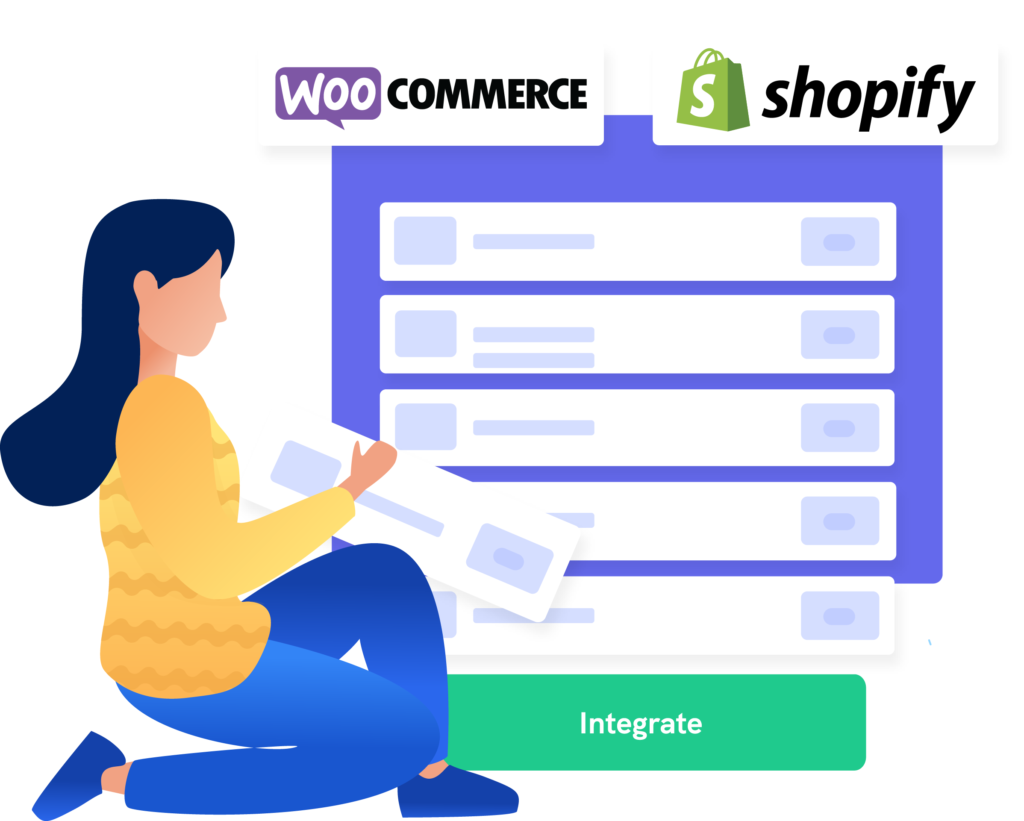
Learn more about how subscriptions are managed on WooCommerce and Shopify, including how the QPilot platform works with both.
Shopify and WooCommerce are two popular e-commerce platforms that allow users to create and manage online stores. Both allow brands to offer memorable shopping experiences but have different strengths and weaknesses.
This is no different for subscriptions, so knowing which platform to use for subscriptions needs to be thought out. In this article, we’ll break down some of the main differences between Shopify and WooCommerce for subscriptions: like how recurring orders are managed, how shipping rates work, how payments are handled, and how QPilot’s platform integrates with each!
How Shopify and WooCommerce Handle Subscriptions
Shopify standardizes how Subscription Apps and integrations are required to work with Shopify’s Subscription APIs. Shopify does not offer its own subscription app, so their Subscription APIs are used by developers to create and manage their own apps and integrations.
Since Shopify controls the cart/checkout experience for all customers, this means Shopify is managing customer experience and legal compliance related to subscriptions. It also creates a standard way for app developers to interface with subscriptions.

WooCommerce does not have a standard set of requirements or API for subscription apps, but there are plugins and integrations that provide a lot of different types of subscription features & functionalities ranging from digital memberships to Subscribe & Save programs.
Each plugin on WooCommerce works differently, so you will get plugins that do different things while also working in different ways. For example, the WooCommerce Subscriptions plugin may require several other plugins to work together to approach some of the functionality for Subscribe & Save (aka “Autoship” or “Repeat Delivery” subscriptions) that you find “right out of the box” with the Autoship Cloud plugin.
The benefit of these differences on WooCommerce is that developers can fully control and customize the customer experience at cart/checkout, providing an opportunity for creative applications of a subscription experience. Things like hosting & legal compliance, however, are up to the store owners and plugin developers.
How Subscription Contracts are Created and Managed on Shopify and WooCommerce
With Shopify’s Subscription APIs, there are strict requirements and a standard process for managing subscriptions. For example, merchants must use Shopify’s Selling Plans to offer any product as a subscription, and customers must purchase subscriptions to products using Shopify’s Subscription Contracts. These contracts act like billing agreements, similar to those used by PayPal Express to create a signed agreement from a customer that gives the merchant offering the agreement permission to charge their credit card for future purchases.
Shopify subscription contracts provide very little data that merchants can use, aside from basic data related to the customer and what was created. You will still need analytics, including views into churn, customer behavior, lifecycle value, and other views that QPilot makes possible.
On both Shopify and WooCommerce, QPilot provides better data insights into what customers are doing with their subscription.
Since WooCommerce does not have a standardized approach to subscription contracts, QPilot’s Autoship Cloud plugin provides greater visibility into subscriptions. This includes how Checkout Orders are linked to subscriptions (QPilot refers to them as Scheduled Orders), including how subscriptions are linked to Orders that have been created in WooCommerce (from the processing of the Subscription Order).
This way merchants can easily see which order was created by checkout or from a subscription order. Read more on how this works here: https://support.autoship.cloud/article/463-how-scheduled-orders-are-linked-to-woocommerce-orders

How Shopify and WooCommerce Process Subscription Payments
Shopify Payments offers a great customer experience and is a simple payment service for merchants that don’t need to work with a specific payment gateway or merchant processor.
Shop Pay is part of Shopify Payments and has quickly grown to be a popular payment wallet to streamline checkout and subscription payments, including connecting with the Shop App. Shop Pay, however, is not available for everyone on the platform. CBD merchants, for example, can’t use Shopify Payments or Shop Pay on one-time or subscription orders.
CBD merchants can’t use Shopify Payments or Shop Pay on one-time or subscription orders
For merchants that do require a payment service other than Shopify Payments, Shopify can be expensive due to additional transaction fees charged to merchants not using Shopify Payments in addition to the fees that are already paid to their payment service.
Shopify has a select number of payment gateways and methods available for subscriptions. You can learn more about their eligibility requirements here. The supported payment gateways on Shopify include:
- Shopify Payments
- Shop Pay
- PayPal Express
- Stripe (requires approval)
- Accelerated Checkouts
- Apple Pay
- Google Pay
- PayPal
- Undocumented
- Authorize.Net CIM
- Braintree Payments
Shopify does restrict the number of payment gateways that you can use with each Shopify Store and strongly prefers Shopify Payments and Shop Pay.
Shopify is similar to WooCommerce in that it relies on Apps to communicate and resolve customer follow up to subscription payment failures like declined credit cards on subscription order renewals.
For merchants, it is best to think of Shopify as a payment gateway: Shopify will attempt to process a subscription payment, and if the payment is not successful, it will notify the Shopping Cart, but take no further action. It is up to the solution provider that integrates with Shopify Subscriptions to actually handle the process and experience of notifying the customer about the payment failure, and directing through the process of updating their payment so that their subscription order can be processed.
WooCommerce is an incredibly flexible platform when it comes to managing subscription payments and one-time payments. If the payment service you’d like to offer has a plugin available, for example, you can offer it in your store. There are no added fees for using your own payment service.

WooCommerce does offer its own WooCommerce Payments service for merchants who don’t require a specific payment gateway, but this service can only be managed and modified by WooCommerce itself so it’s no surprise that many merchants are downloading plugins that integrate WooCommerce with their chosen payment service.
For subscriptions, the same is true, depending on a few factors like if the subscription plugin you’re using will also work with the same payment plugin.
WooCommerce can also handle multiple payment gateways and methods. This is useful when a merchant wants to use PayPal for international payments, or Braintree for domestic orders, as an example. Not all payment services work out of the box with subscription payments, however, so be sure the subscription plugin you choose works with your preferred payment provider.
All of QPilot’s payment integrations work on WooCommerce through the Autoship Cloud plugin: https://docs.qpilot.cloud/docs/how-payments-work
For failed subscription payments, QPilot can be set up to notify Subscribers about a failed payment and link to My Account to update their failed payment. QPilot uses WooCommerce’s My Account > Payment Methods to update the saved credit card information.
How New Subscription Orders Are Created in Shopify and WooCommerce
Shopify requires that new subscriptions only be created by going through a Shopify Checkout, so that the order can be processed and billed as expected, whenever 1+ items selected for Subscribe and Save are in the cart.
WooCommerce, with its greater flexibility, allows for many different ways to create subscription orders. It’s possible to create new subscriptions through the Checkout, My Account page, or other completely customized experiences.
WooCommerce, with its great flexibility, allows for many different ways to create subscription orders.
For example, QPilot’s Autoship Cloud plugin offers links, buttons, and shortcodes for merchants to quickly add subscription actions to their sites, and developers have extended both the Autoship Cloud plugin and QPilot’s APIs to create custom sign-up processes, custom step forms, meal kits, and more… for WordPress developers, the sky’s the limit when thinking about how to create subscription and payment experiences.
How Pricing Changes are Managed on Subscriptions Orders in Shopify and WooCommerce
A new feature on Shopify (as of Q4 2022) is the ability to uniquely discount prices per Subscription Billing Cycle. For example, a discounted subscription price can be 10% on the first billing cycle and 15% on the second, etc.
Shopify restricts the number of pricing discounts on each product option to 1. They do provide the ability to offer a different discount based on the frequency selected.
As of Q1 2022, you need to use theme customization to explain to the customer that there is a different discount on checkout versus recurring orders, as this is not displayed natively within Shopify.
Shopify Subscriptions do not support many B2B features including role-based, or quantity discounting on Subscription Orders. Shopify Plus offers some of these features for one-time purchases and checkout.
WooCommerce does not restrict any pricing changes or discounting. Merchants are able to specify a discount at Cart/Checkout and a different discount for recurring orders. This is easily displayed on the product page as well.
QPilot enables B2B, role-based, or quantity discounting on subscription orders.
Because WooCommerce has no restrictions on price discounting, B2B, role-based, or quantity discounting can all be integrated with Subscription Orders. For example, QPilot’s Autoship Cloud plugin has been integrated with popular Wholesale and B2B plugins that offer features for discounting one-time and repeat subscription orders.
How Migrations for Subscriptions Are Done on Shopify and WooCommerce
Migrations on WooCommerce can be relatively straightforward because WooCommerce does not own the saved payment methods (or tokens), since those are owned by your payment gateway (unless you’re using the WooCommerce payments service). Merchants can generally expect to be able to completely migrate to and from different services using CSV exports & imports.
Migrating from different plugins within WooCommerce should focus on ensuring that the Customer ID’s and Products are the same between sites or that they are re-mapped as part of the migration.
Migrating to Shopify or from another subscription app is made easier by QPilot’s migration process, team, and platform.
On Shopify, migrations can be more complicated because Shopify (Shop Pay, Shopify Payments) creates its own payment token in addition to any payment tokens created with your payment gateway. It is a case-by-case basis if you are leaving Shopify to go to a different platform.
Migrating within Shopify can be done easily if the Subscription Apps in question both work with Shopify’s eligibility requirements and Shopify’s native checkout. This is easier because both will use the standard Selling Plans and Subscription Contracts created within Shopify’s Subscription APIs.
How Customers Access My Account for Subscriptions on Shopify and WooCommerce
On both platforms, customers can access their subscriptions through the My Account portal on the merchant’s website. One of the new options available on Shopify for Subscription Customers is the ‘passwordless’ login. This means that Customers are not required to create an account at checkout, but instead set up an account when they try to first access the My Account page on the merchant’s site.
WooCommerce prefers an account to be created when customers are checking out with subscription items, although it does have a built-in workflow to support guest checkouts and this does work with subscriptions.
How App Integrations Are Managed on Subscriptions for Shopify and WooCommerce
Since the Shopify Subscriptions are restricted to specific requirements, testing, implementing, and managing other integrated Shopify Apps can be much easier than managing other plugins for WooCommerce.
On WooCommerce, since the platform is open-source and not standardized in the same way as Shopify, adding plugins can be a tricky endeavor. QPilot always recommends testing new apps on a staging site to ensure you don’t adversely affect your live site, on WooCommerce or Shopify.

Other Key Differences Between Shopify and WooCommerce on Subscriptions
Coupon Applications and Discounting
- WooCommerce does not limit stacked coupon discounts, while Shopify does
- Coupon codes can be shared with orders create in WooCommerce, but not on Shopify
Zapier
- Both platforms have Zapier integrations available
- Enable winback campaigns on WooCommerce with a Zapier-QPilot-Klaviyo integration
Shipping Rates
- There is no limit on split shipping in WooCommerce, but Shopify will aggregate different shipping costs into one price to show the customer at checkout.
- Real-time shipping rates on subscriptions available through QPilot on both WooCommerce and Shopify
Subscribe Portal in My Account options
- On WooCommerce, the Autoship Cloud plugin powered by QPilot can use hosted iFrame or a Native UI that is customizable via WP/PHP templates
- On Shopify, QPilot uses a hosted iFrame for Subscription Orders within My Account
- On Shopify, a Native UI with customizable Liquid templates are coming soon for QPilot
Diving deeper into how each platform approaches subscriptions will give you a better idea of which platform to choose for your program. QPilot is available on WooCommerce through the Autoship Cloud plugin, and on Shopify with the QPilot app.